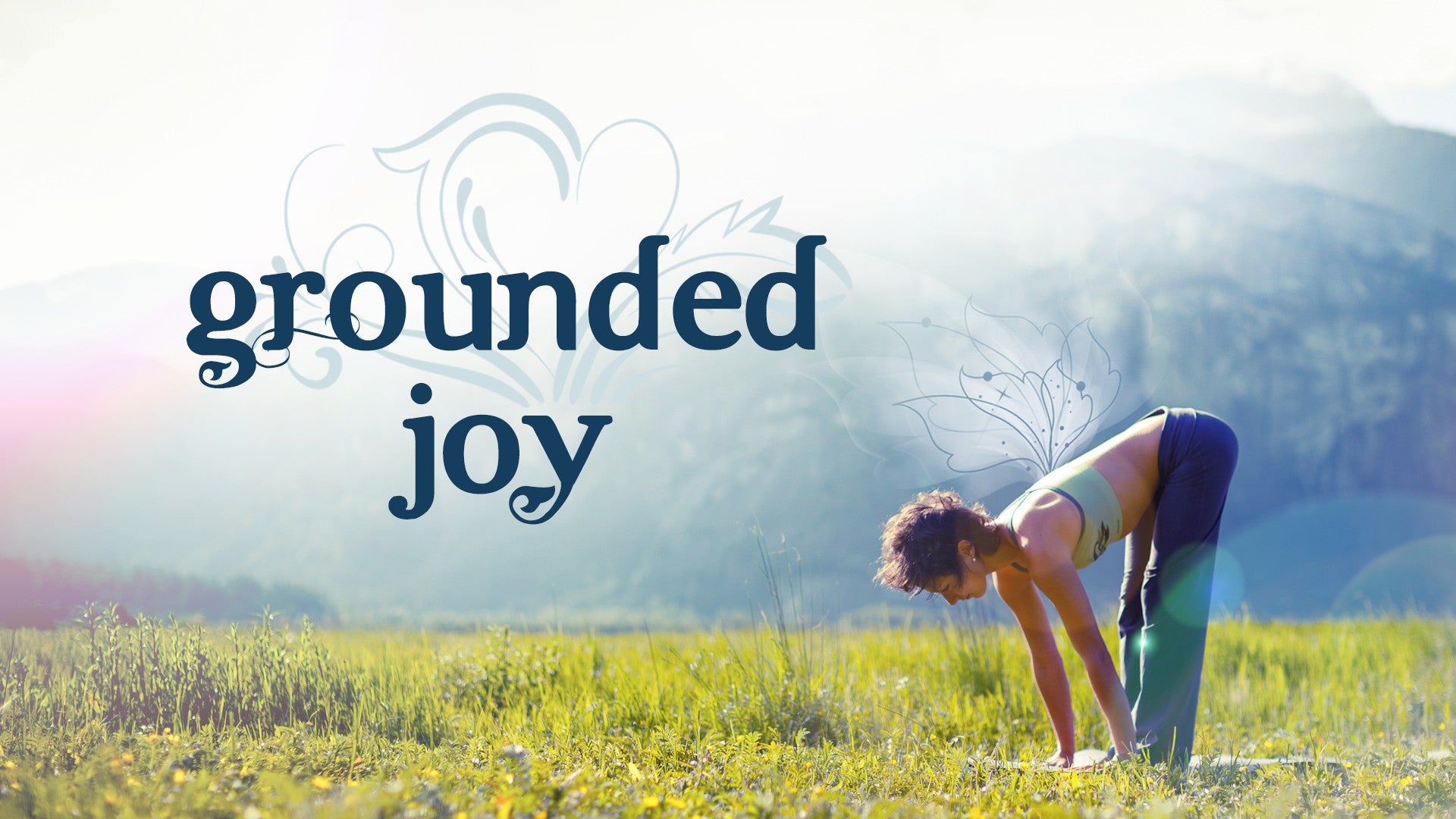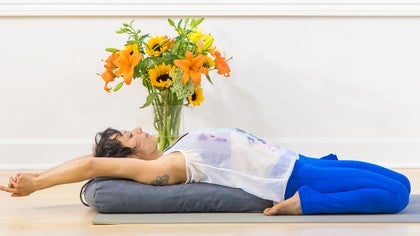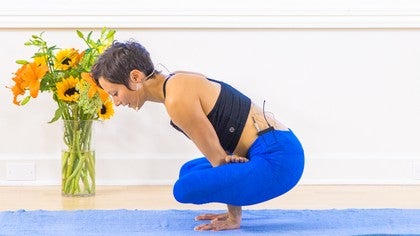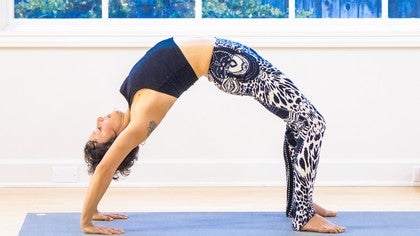Description
Transcript
Read Full Transcript
(waves rolling) Hi. This is a Padmasana or Lotus afternoon practice. I'm doing it on a blanket. And honestly, sometimes I do this one in my bed before I got to sleep. And I like the feeling of a little bit of softness underneath me sometimes.
There is a little bit of wrist stuff in this practice so actually, just a thin blanket on your mat is really nice. I just like the softness underneath me for the practice. And maybe after the practice you feel like sitting in meditation for a little while. You don't have to be able to get into the lotus pose to do this practice. You could practice it with one ankle crossed over the other in most variations and just be creative how you can do a cross-legged practice with all of the different movements that we're doing.
I'm just gonna show the Padmasana practice. So starting out with Ardha Padmasana. And we're gonna take the left heel into the right sit bone, open up the right hip and take it across to the top of the left groin. Take your hands on your knees. A little bit of movement through your inner heel and breathe.
If you feel really slumped backwards, you could roll up your blanket and support your sit bones a little bit. Try to breathe evenly through the front and the back and the sides of your diaphragm. I'm not gonna do it for this practice but you could for each of these postures set a timer and time it for one or two minutes a posture. Or maybe less, 30 seconds. So then we'll let our left leg come out, drop the right knee a little closer to the earth if you can, lean on to that left side and slide the left leg towards Padmasana position.
Sometimes, if this knee is floating, it wants to be supported so you could have something there to support it. Then breathing. Noticing how it feels. Do you need a prop? What's happening in the sealing of the knee joints?
Is the underside of your legs fairly relaxed? Hamstrings, back of the calves. Let's do a few arm movements in this now. So, you can stay here on your mat but I'm gonna turn around this way to just show you the shoulder movements. The first one is Parvatasana.
Interlocking your fingers in front, flip your hands away, shoulder blades slide down and then allowing your arms to come over your head without back bending. And you might sway a little side to side. Straighten the arms a little bit more and see if you can have the inner shoulder blades sliding down the back. And exhale and release. Switch the crest of your knuckles, so opposite index finger in front.
Turning away. And sliding up. The elbows can be bent at first and then maybe once you come up you can kind of wiggle the sides of your ribs into more length and start to straighten your arms. Breathe into any of the congestion that you feel in your shoulders, the top of the shoulder head. If there's a feeling of the joint pressing against bone, see if you can bring a bit more space just through your awareness.
Exhale and release. Holding your right elbow with your left hand, keep a relaxed shoulder and bring that elbow in line with your ear, take your hand behind your head. You could use a strap for this one if you want. Gomukhasana arms internally rotate your left arm and slide it up the back. So you can just reach and breathe there or if it feels like the fingertips can find each other without too much tension.
External rotation of your right shoulder, internal rotation of your left. And then release, let's try the other side. One side might feel way harder for you, particularly in the internal rotation of the shoulder which is for me this side, the right arm, a lot stickier in the front. You might see that I have a bit of a winging shoulder blade on that side. And so, see if I can effort to bring the shoulder blade into the back.
And exhale and release. Inhale the hands forwards, flip the palms away from you, reverse Namaste or Namaste II. Either the knuckles can come together. Or if you can get a little curly in this one, it sort of helps to take the fingertips together, maybe wiggle them up the back. Let the fingertips touch.
It feels nice for me to almost flex the fingers and press the fingertips into each other without back bending. And anytime you need to come out of your Padmasana you can and just shake out your legs and come back in. This is almost like a long Yin hold to open up your Padmasana. Exhale and release. I'm gonna turn back this way.
And all the way to the front of the mat so that you have some space here and I'm gonna fold forwards in this position. So Yoga Mudrasana II. So if you have your lotus legs, sometimes the tendency is when you fold forwards to actually tip your bum up a little bit, so think about grounding through the backs of your sit bones. Inhale and coming up. And work yourself a little further forwards on the mat maybe and use your hands to support you, maybe one elbow at a time, to come down towards Supta Padmasana.
Drawing the knees in towards you. May even feel nice to curl up. Noticing how all these variations change the feeling. And then for one of the Matsyasana's, the Fish Pose, Matsyasana. Hold on to your feet and start to let your lotus come away from you, but keeping a little bit of abdominal drawing down towards the floor.
So you're not letting too much of an arch come into your lower back. And I really like to do this slowly. Maybe pausing along the way. And if it feels right, the arms can come over the head which will encourage a bit more of an arch and as long as it feels nice, it's okay but maybe if it starts to feel a little bit compressive in the back, using a little bit of the abdominal constraint to draw down. Let's take the elbows by the sides, hold on underneath your lotus hips, come up onto the elbows, walk the elbows a little close and I'm actually gonna walk my hands more down towards the bottom of my buttocks.
Let a back bend come in here for Paryankasana I. And let the back of my skull come down. For some people it's okay to have the back of the skull down and use your elbows for support if the neck doesn't want to have weight bearing in this position. But sometimes you can bring a little bit more of the curve into the upper back and it's more of a cervical curve but it might feel nice and then you might be able to let go and press your head into the earth enough so that you're using a little bit of the neck muscles. And the arms can come over the head.
Paryankasana I. Paryankasana II, exploring, holding onto opposite elbows. I like to wiggle side to side so that the forearms come closer to the floor. This is a beautiful opening in the sides bodies. (chuckles) The side bodies.
The sides bodies. And then you can release and switch your hands, wiggle space. Make sure you're still looking down the nose tip towards the ceiling is very helpful here so that you're not compressing the base of the skull. And then let's come out. I hold on, I kinda lift my lotus, tuck the chin and roll down.
And then I'm gonna bring my lotus in and use my elbows and then one of my hands to come up. I'm gonna walk my lotus back, come onto the knees and come all the way down onto my belly for Adho Mukha Matsyasana. I'm gonna try to lengthen my lower back out and drop my tail bone and that's gonna open up the front of my groins. I love this posture. You could try it with your legs crossed as well.
So if you're in the cross legged variations, remember that we're gonna do this whole sequence on the other side so keep one leg crossed in front of the other the whole time and then we're gonna switch onto the other side. So this is Adho Mukha Matsyasana. Urdhva Mukha Matsyasana is an upward dog in this position. So I come up, engage a little bit the belly so I'm lengthening out the back. And then rolling some space into the belly.
The heart. And the chest. And then you can come up. And sit down. And I'm gonna twist to the left.
So twist to the left. And see if I can take my left lotus toe for Parivrtta Padmasana, twisted Padmasana. Some people like to invert the hand here for a wrist stretch. That tips you a bit more forward so you can see how it feels. I like to be a little bit straight up in a twist so that the pallet and the perineum are aligned.
We're gonna come back to the center and we're gonna try Garbha Pindasana. So, bringing the legs up, the right side is a tighter lotus leg than the left. And so I'm gonna do that arm first. And see if I can get it through. Because it's harder to do the second arm so I'm balancing here and I'm gonna try to get that left arm through.
This might feel crazy for you to even go there. And some people do things like wet their arms and legs to slide a little bit. Slippery pants do help. Or you can hold and see if you can maintain your lotus upright like this. So I'll show you this.
And holding your chin. There's an extreme flexion in the spine so see if you can lengthen the belly in this one a little bit. So two hand variations, holding the chin or holding the head. Holding the chin gets you a little out of the flexion, holding the head is a little bit more flex. You can play with it.
Then I'm gonna let my elbows free so that they're not right through like the bend but they're just back a little bit. And I'm gonna try to come into Kukkutasana. Which is a shift of weight, you can try a couple of times, and really hold my fingers into the earth. So really press down into the fingers to decompress the wrists just for a couple breaths. And then release, only a couple more.
We're coming out of this, Gorakshasana, this is a fun posture if you've never tried it. Coming up onto your knees. Walking up a little bit like this, seeing if you can balance and draw the tailbone down. You can feel length in my lower back and come up. (giggles) Two more postures.
I'm gonna turn this way. Left leg is on top of the right here, so I'm gonna make that big sweeping movement to catch my left like we did in Parivrtta Padmasana. This one we're gonna try to take the other toes. So a tighter lotus with the toes hanging off is a little bit more easy to find those toes. Again, I'm making that big sweeping movement fairly relaxed.
I'm not desperate to get into this but maybe I find the toes. It's also nicely done just grabbing a hold of the elbows like that. This puts you more into an extreme extension in the back. Pour a little bit of its opposite in. And then finally, Yoga Mudrasana.
Either the head, dropping the sit bones, or the chin. Then come up and let go of those legs. Notice how they feel, wiggle your toes. Release your knees. Might feel nice here to come onto your forearms and just windshield wiper the legs.
And just let the knees come together and in this kind of couch potato position in your upper back, floss out your knee joints. Flushing them out. Okay. So we're gonna do that whole sequence with the other lotus leg. Left leg first.
In some schools, they only do lotus on the right leg so this is... meant to create an energy circuit that you sort of hone. I did that for a long time and it really imbalanced my hips so I really like this practice for realigning and finding a little bit more of a balance through the hip joints. So at first, the half Padmasana for a couple of breaths you might try with the left leg on top. And then move into the Padmasana with the right leg.
Just take a few breaths. You might find a mudra here. You might want to support your knee. Little bit of the movement of the inner heel. There's something magic about the postures and threading them together.
Just notice if anything is changing as you do the practice, as you participate. Parvatasana, so you can stay where you are. I'll just show you. I'm doing my right index finger in front. So probably you're not in a photo shoot so you can wiggle around in your postures.
Breath and heartbeat are not static, neither are these asanas. Other side. Think about the yogis who first started doing these asanas, this exploration of movement in the body. Before they wrote them down and made pictures. Imagine you were the first person to explore some of these postures.
What would it look like for you? Exhale. So right hand holds the right arm, slides it back. Internal rotation. Gomukhasana.
I like moving the head in these a little bit. So you look down, it's a different feeling. You look up, it's a different feeling. Subtle movements in the spine, fairly straight spine. Switch.
Internal rotation. Deep breaths. Unwind. Inhale, the arms sweep forwards. Exhale, reverse Namaste, get a little curly.
Restraighten. Re-enliven. Fingertips pressed gently. Shoulders loop, a little bit wide. And release.
I'm gonna turn back this way but you can stay where you are. For Yoga Mudrasana II. So I'll walk forwards. And root down the outer hips. So we can think about the outer hips rooting down but the sacrum sliding in and forwards.
Just that subtle movement makes me feeling so much more happening in the hip joints. So much more energy and aliveness in the hip joints. Inhale, coming up. We're gonna come onto our backs. You can shift forwards if you need that mat space.
Come on back. Roll down and bring the knees in towards you. You can even rock side to side. So there's an external rotation in the hip joint, quite an extreme one to get into lotus but once you're in it, like I was talking about, pour a little bit of the opposite into the posture you can almost think about internally rotating your legs so the inner knee kinda rolling down and there's something that happens in the hip joint when you do that. It sort of just centers it.
And that talk about boxing the joints, something happens. So going into Matsyasana. One of the Matsyasanas. Slow. Somewhere here I feel like my hips are gonna kinda pop.
So I'm gonna try to, instead of all that holding that I'm doing in my hips, draw my belly back. And see if I can kind of move around that feeling of tension. Maybe even if I just pause and breath into it. Oh, there it goes. Once you feel that culmination of tension, sometimes it's interesting to see if you can soften it and see where if the body's holding in a certain way.
If it's okay with that abdominal drop, you can take your arms over your head. The ribs might want to come up. Can you feel them? If you feel them coming up a lot, it's just like your arms in conversation to somebody. Cross your arms, take your hands on your lower ribs and just do a little tug of the skin down.
Then breathe freely. Paryankasana. So we'll come up a bit with the lotus, hold on. Come up onto the elbows. I'm gonna need to walk down a bit, 'cause for some people you have to walk quite far down towards the base of the buttocks for a long arch to come onto the back of the skull.
So here... Or maybe a little bit more cervical curve but make sure you look down the nose tip towards the ceiling. Leaning the skull into the floor. Cross one elbow, wiggle. Pubic bone and tailbone move down and towards each other.
And I'm doing a tiny little tuck of my chin here so that I can feel a little bit of containment in the front of the throat and a little bit of a length in the back of the throat, other elbow. And let's come out. Take the lotus in, release anything in the low back, use your elbows to come up. Come back a bit. And out of Mukha Matsyasana, coming forwards.
Maybe coming onto the elbows to start. Instead of just letting my lower back really arch I'm gonna drop my tailbone, slide my sacrum into the back of the pelvis. And you could also lay on a bolster here. And I'm continually working at smoothing out the lower back. I'm sort of ballooning breath in there and lifting.
Urdhva Mukha Matsyasana. So I come out a little bit. Roll around and then come into like an upward dog like this. And exhale. So, Parivrtta twisting.
I'm gonna twist now to the right. Getting the bind sometimes makes you arch your back and hold your back muscles 'cause you're trying to get the bind so if you have the bind and you're in that position, drop your tailbone and almost lean your back into your arms so that you can fill up your back muscles. Okay, so Garbha Pindasana. The tighter one first. And the elbow has to come through for it to bend.
Try the other one. Head. Chin. My mic is getting in the way a little bit here. Or holding and balancing, almost like a Navasana, the boat pose in this posture.
So sliding out enough that your elbows are now above the lotus and trying that Kukkutasana. So a little bit of, pretty sure Kukkutasana is rooster. One. Two. And this time, go a little bit further forwards and catch yourself on your fingers.
You really have rooster fingers here, little claws digging into the earth. And exhale and come down. Gorakshasana is that one where you come forwards. Tailbone down, smoothing out the back muscles. See what it's like to balance.
Woah. Breathe. And coming forwards for... And I'm moving around just to show you but you can stay on your mat in the way that you do. I'm gonna take the right one first.
And then I'm gonna make that big sweeping relaxed movement. So. (exhales) Relax. Sweep. And a way to get into this is to really find the big toe.
So hooking around the big toe. And the big toe's working a little bit also because it's kind of resisting the hook so that there is a feeling of grabbing. There's a back bend so where the arms are, lean back into that and breathe. Baddha Padmasana and then Yoga Mudrasana I. Head or chin.
Sit bone's heavy. And now come up. Release your legs. Wiggle your toes. Windshield wiper.
So you might feel like sitting in a meditation. I don't feel like that right now because I feel like there was a lot of work in the legs and I don't want to go back into that position of being seated, I want to allow that meditation to happen lying down and releasing the legs so that's what I'm going to do. And I'm gonna take this blanket, which has cushioned me, and placed it over top of me. So Shavasana. So you can rock your heels here and just feel a sense of relaxation coming through the legs, especially the knee joints and the hip joints.
Roll your head side to side. Close your eyes. I've been reading a lot of Anne Lamott and one thing I read of hers' this morning was agree to have an awakening. Like, are you in agreeance to have an awakening? Are you open...
to have an insight? It's so great to say no to so many things. But to this one, it's pretty great to say yes. There's something magical about the yoga postures, the asanas. And it's impossible to split the body from the mind.
So just notice what's happening. And attend to that for a couple more minutes. So you might want to stay here for a little bit longer. Or you can make your little movements to come up. Let's take the hands together at the heart and close with an Om shanti shanti shanti.
This is called a shantipath and there's three shantis which are peace. And they're meant to be peace towards different things. The first one is peace in yourself. The second one is peace with others. And the third one is peace to the things that you cannot control.
Inhale deeply. Exhale fully. We'll do it twice, inhaling. ? Om shanti shanti shanti ? Om shanti shanti shanti Namaste.
Grounded Joy
Comments
You need to be a subscriber to post a comment.
Please Log In or Create an Account to start your free trial.











